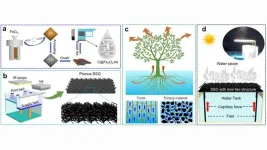A new publication from Opto-Electronic Advances; DOI 10.29026/oea.2024.240099 discusses an on-chip spectrometer with high performance, low power-consumption and simple control logic.
The miniaturized spectrometer has emerged as a powerful tool for analytical applications, particularly due to its promising potential in portable settings. These devices are increasingly integral in various sectors, including health monitoring functions on wearables like smartwatches and food quality inspections through smartphones.
Traditionally, high-performance spectrometers have been bulky and power-intensive, suited more for laboratory settings than for field use. However, the demand for portable, efficient, and powerful devices has led to innovative solutions to overcome these limitations. One such inspiration comes from the field of computer engineering, particularly from the management strategies used in multicore central processing units (CPUs). In these systems, a technique known as 'core parking'—where some cores are temporarily turned off when not needed and reactivated for tasks requiring high computational power—has proven effective. This strategy significantly enhances energy efficiency, particularly under light load conditions, by balancing power consumption with performance needs.
Inspired by the core parking strategy of multicore CPUs, the authors of this article developed a miniaturized spectrometer based on programmable photonic circuits. Their design incorporates an array of Mach-Zehnder Interferometers (MZIs) which adopt a comparable 'park' operation strategy. In this innovative configuration, many of the interferometers remain inactive or 'parked' during periods of low demand, thereby conserving energy by significantly reducing power consumption. This approach slightly degrades spectral resolution but proves immensely beneficial for applications where extreme precision is not paramount but low power usage is crucial.
Moreover, for scenarios requiring high-resolution spectral analysis, the spectrometer is capable of shifting to an ultra-high-performance mode. This is achieved by activating additional interferometers to create more complex spectral codes, thereby facilitating exceptional spectral resolution and expansive broadband bandwidth. Such versatility allows the device to meet diverse application needs—from basic consumer health monitoring to advanced scientific research—within the constraints of portable device capabilities.
To further enhance the spectrometer's efficiency, the authors have also focused on optimizing the design of the interferometers through inverse design techniques. These optimizations ensure that the interferometers are exquisitely sensitive to the heaters within them. As a result, altering the spectral coding requires minimal power, thereby maintaining the device’s low-energy profile even during high-performance operations.
This paper addresses the intricate dilemma faced by developers of portable spectrometric devices: how to deliver high-performance analytical capabilities without compromising on energy efficiency. By adopting a strategy inspired by advancements in computing technology, the researchers have successfully developed a spectrometer that not only meets but exceeds the dual requirements of high functionality and low power consumption. This breakthrough has significant implications for the future of portable devices, making sophisticated spectrometric analysis accessible in everyday settings without the typical constraints associated with professional laboratory equipment.
Keywords: silicon photonics / integrated spectrometers / computational spectrometers
# # # # # #
The National Key Laboratory of Microwave Photonics (Tianyuan Laboratory) was established in July 2023 and is built upon Nanjing University of Aeronautics and Astronautics. The laboratory aims to become a world-class comprehensive research platform, serving as the overall strategic planner, innovation mechanism developer, frontier technology pioneer, and new quality capability creator in the field of microwave photonic technology in China.
The laboratory addresses major national needs by focusing on four key scientific issues: efficient interaction between microwave and optical waves, precise multi-field matching on-chip, fine-tuned multi-dimensional parameter control, and efficient multi-domain resource coordination. Research areas include high-efficiency microwave photonic functional devices, large-scale integrated microwave photonic chips, multi-dimensional microwave photonic processing and control, and high-performance microwave photonic system applications. The research outcomes are expected to solve critical bottleneck problems in relevant national fields and play a significant role in national security and the national economy.
The laboratory currently has 165 full-time researchers, with 61 talents at or above the provincial and ministerial levels, accounting for 41% of the staff (including 2 academicians, 11 national-level leading talents, and 15 national-level young talents). Senior titles account for 91% of the staff. The laboratory covers an area of 15,000 square meters, with research instruments and equipment valued at over 210 million RMB, and ongoing research funding exceeding 400 million RMB. The laboratory has led to the achievement of more than 50 national and provincial-level awards, including the Second Prize of the National Natural Science Award and the Second Prize of the National Science and Technology Progress Award.
# # # # # #
Opto-Electronic Advances (OEA) is a rapidly growing high-impact, open access, peer reviewed monthly SCI journal with an impact factor of 15.3 (Journal Citation Reports for IF2023). OEA has been indexed in SCI, EI, DOAJ, Scopus, CA and ICI databases, and expanded its Editorial Board to 31 members from 17 countries with an average h-index of 62.
The journal is published by The Institute of Optics and Electronics, Chinese Academy of Sciences, aiming at providing a platform for researchers, academicians, professionals, practitioners, and students to impart and share knowledge in the form of high quality empirical and theoretical research papers covering the topics of optics, photonics and optoelectronics.
# # # # # #
More information: http://www.oejournal.org/oea
Editorial Board: http://www.oejournal.org/oea/editorialboard/list
All issues available in the online archive (http://www.oejournal.org/oea/archive).
Submissions to OEA may be made using ScholarOne (https://mc03.manuscriptcentral.com/oea).
ISSN: 2096-4579
CN: 51-1781/TN
Contact Us: oea@ioe.ac.cn
Twitter: @OptoElectronAdv (https://twitter.com/OptoElectronAdv?lang=en)
WeChat: OE_Journal
# # # # # #
Li A, Li YF, Wang C et al. An inversely designed integrated spectrometer with reconfigurable performance and ultra-low power consumption. Opto-Electron Adv 7, 240099 (2024). doi: 10.29026/oea.2024.240099
END





